By David Nickum.
In the final weekend of July, I teamed up with Dustin McCory against 29 other teams, all focused on a simple - but surprisingly difficult - challenge: each team member had to catch a fish from out of eight different rivers over two days. Of the 30 teams competing, only 12 completed that challenge. Dustin and I were among the majority that came up short, but we had a great time experiencing some of the best rivers Colorado has to offer.
The "8 River Rodeo" was started by Joe Wilson 10 years ago. Its origins came from Joe's experiences fishing with his buddies - one of whom could never seem to drive past a promising-looking section of water without asking them to stop and fish. After several such stops, another friend told him that "fishing with you is like fishing in a rodeo!" And the idea of the 8 River Rodeo was born. Joe offered to organize the event, but only if it was done as a charity fundraiser. Over the years, proceeds from the Rodeo have gone to support Colorado Trout Unlimited and Project Healing Waters.
 Now organized by Clint Crookshanks, the Rodeo is held over the final weekend of July. Participants gather on Thursday night in Glenwood Springs to meet up and get their measuring troughs (to document the size of each of the up to 16 fish scored). On Friday, the teams spread out - fishing on public water only - to tackle the first four rivers: the Fryingpan, Roaring Fork, Crystal, and Colorado. On Saturday, action moves to the Gunnison basin with teams fishing the East, Gunnison, and Taylor Rivers as well as Spring Creek. If an angler misses one of the Friday rivers, they can make it up with the Slate as a fifth Saturday river.
Now organized by Clint Crookshanks, the Rodeo is held over the final weekend of July. Participants gather on Thursday night in Glenwood Springs to meet up and get their measuring troughs (to document the size of each of the up to 16 fish scored). On Friday, the teams spread out - fishing on public water only - to tackle the first four rivers: the Fryingpan, Roaring Fork, Crystal, and Colorado. On Saturday, action moves to the Gunnison basin with teams fishing the East, Gunnison, and Taylor Rivers as well as Spring Creek. If an angler misses one of the Friday rivers, they can make it up with the Slate as a fifth Saturday river.
I fished in my first Rodeo last year and - beginner's luck - actually completed all eight rivers (albeit by using the Slate on Saturday to make up for missing out on the Fryingpan on Friday). I came in with Dustin this year with a gameplan - which actually matters given the combination of fishing and windshield time (driving between rivers) that you need to manage. We were going to tackle the Fryingpan first thing - head to the "toilet bowl" at dawn - and then work our way down to the Roaring Fork, then the Colorado, and finish on the Crystal as we headed toward Kebler Pass in the evening to be ready for the Gunnison basin on Saturday.
 We stayed in Basalt and made it to the dam before sunrise. Only to find a line of folks already in place waiting to cast into the pool immediately below the dam. We went a bit downstream, crossed to the opposite side, and fished the far bank. Dustin landed his fish first - not a trophy, but a nice 15" brown trout. We relocated below the bridge where I landed a 12"er and was thus able to record my first Rodeo trout on the Fryingpan. One river down - and not even 9 am. We were flying high!
We stayed in Basalt and made it to the dam before sunrise. Only to find a line of folks already in place waiting to cast into the pool immediately below the dam. We went a bit downstream, crossed to the opposite side, and fished the far bank. Dustin landed his fish first - not a trophy, but a nice 15" brown trout. We relocated below the bridge where I landed a 12"er and was thus able to record my first Rodeo trout on the Fryingpan. One river down - and not even 9 am. We were flying high!
But flyfishing has a way of humbling you, and that was the story of the rest of our Friday. We dropped onto the Roaring Fork just below Basalt. Before too long, I landed an 8" brown trout - I kept fishing in the hopes of picking up something larger, while Dustin continued pursuing his first Roaring Fork fish. To no avail. We headed down to the confluence with the Colorado, where I could cast onto the  Colorado while Dustin continued to hit the Roaring Fork - but close enough where we could both get to the other with the measuring trough if we landed something. We struck out there. Crossing the bridge and dropping to the opposite bank, Dustin caught our best fish of the weekend - an 18" whitefish. I continued to get nothing.
Colorado while Dustin continued to hit the Roaring Fork - but close enough where we could both get to the other with the measuring trough if we landed something. We struck out there. Crossing the bridge and dropping to the opposite bank, Dustin caught our best fish of the weekend - an 18" whitefish. I continued to get nothing.
We moved downriver to West Glenwood where I proceeded to hook and then lose two fish before I could get them to net. Taking a deep breath I patiently tied on another two nymph rig, said a small prayer to the river gods, and tossed my flies into the stream to drift downcurrent and give me tension for making my first cast. WHAM! A 12" rainbow hits the bottom fly before I even have a chance to make that first roll cast. Sometimes luck serves better than skill!
With the Colorado behind us, we zipped back up to Carbondale to return to the Roaring Fork - by this time rain was setting in and it was close to 6 pm. We needed to refuel the car, so I offered to grab sandwiches and gas while Dustin kept fishing. Luck was with us as he caught a small but score-able brown trout. We headed up the Crystal towards Redstone, hoping to catch our final fish before darkness fell. But between already high water, further exacerbated by the rain, and rapidly dimming light conditions we gave up on the Crystal and started the drive across Kebler Pass in the darkness, the main excitement coming from avoiding a boulder that had fallen on the road from the rain-softened slopes.
 Saturday started with high hopes to get fish from five rivers and still complete our rodeo. But the luck that had been with me on the Colorado left me on the Gunnison. Fishing below the town of Gunnison in the morning, I hooked - and lost - a series of three fish. Dustin was also having no luck, so we decided a change of scenery was in order. We headed up to the Taylor River where we found a beautiful pool - complete with a break in the riverside trees to allow for a clear backcast - and both hooked into rising browns to score our Taylor River fish. Four rivers down - four to go.
Saturday started with high hopes to get fish from five rivers and still complete our rodeo. But the luck that had been with me on the Colorado left me on the Gunnison. Fishing below the town of Gunnison in the morning, I hooked - and lost - a series of three fish. Dustin was also having no luck, so we decided a change of scenery was in order. We headed up to the Taylor River where we found a beautiful pool - complete with a break in the riverside trees to allow for a clear backcast - and both hooked into rising browns to score our Taylor River fish. Four rivers down - four to go.
Sadly for me, that was as far as I got - four rivers completed. We went on to Spring Creek, where we fished the first meadow with dry flies. The fish seemed to be taunting us, rising near our flies but never hitting even as we kept trying new patterns and sizes in the hopes of getting the right bug in the right place at the right time. It was not to be, and as afternoon was already rolling along - and rain resuming - we concluded that we wouldn't be completing 8 rivers but we might as well at least FISH them all. So we  headed over to the Roaring Judy Hatchery to fish the public reach of the East River there. Fishing around a tree with branches hanging over the river by where the hatchery springs flow out into the East, Dustin landed another brown trout. We swapped rigs, figuring that his set up would give me the best chance to land one as well. Of course, Dustin proceeded to hook another fish on my rod and fly ... another lesson in humility for me.
headed over to the Roaring Judy Hatchery to fish the public reach of the East River there. Fishing around a tree with branches hanging over the river by where the hatchery springs flow out into the East, Dustin landed another brown trout. We swapped rigs, figuring that his set up would give me the best chance to land one as well. Of course, Dustin proceeded to hook another fish on my rod and fly ... another lesson in humility for me.
 We finished the evening fishing the Gunnison at its source - the confluence of the East and Taylor Rivers - as a light rain continued to fall. While we hadn't succeeded - indeed, hadn't even come particularly close - it had been a great experience to fish together at so many different, beautiful spots in such a short time. We called it a day and headed over to the Almont Resort for dinner.
We finished the evening fishing the Gunnison at its source - the confluence of the East and Taylor Rivers - as a light rain continued to fall. While we hadn't succeeded - indeed, hadn't even come particularly close - it had been a great experience to fish together at so many different, beautiful spots in such a short time. We called it a day and headed over to the Almont Resort for dinner.
We found out that while we had struggled, the other Colorado TU team - Heather Sees and Niki Cousins from The Greenbacks - had completed all eight rivers (both using the  Slate to replace the Crystal, which they like us had missed on Friday). Those well-earned smiles on their faces come with one year's worth of bragging rights - at least until the 2018 Rodeo. Overall, 12 of the 30 teams completed all 8 rivers. For the 10th anniversary year, there was also the option to complete 10 rivers (adding Brush Creek and Cement Creek on Friday and Saturday respectively). Three teams actually completed all 10 rivers - including the overall winners, the Triple Haulin' Nymphers (Dan Lundahl and Earl Hecker), who scored 257.3 inches on the 8 rivers (that's an average fish length of 16 inches!) plus another 51.8 inches on the two bonus rivers.
Slate to replace the Crystal, which they like us had missed on Friday). Those well-earned smiles on their faces come with one year's worth of bragging rights - at least until the 2018 Rodeo. Overall, 12 of the 30 teams completed all 8 rivers. For the 10th anniversary year, there was also the option to complete 10 rivers (adding Brush Creek and Cement Creek on Friday and Saturday respectively). Three teams actually completed all 10 rivers - including the overall winners, the Triple Haulin' Nymphers (Dan Lundahl and Earl Hecker), who scored 257.3 inches on the 8 rivers (that's an average fish length of 16 inches!) plus another 51.8 inches on the two bonus rivers.
As the evening wound down, Joe Wilson asked if he and his teammate - another Joe - could join us at our cabin if we still had an extra room; they had been camping and with the rain continuing were looking for a warm bed and hot shower. Only when they arrived did I realize that the "other Joe" was none other than author and big-fish guru Joe Butler. We got to enjoy an evening with some great fishing tales from Joe's adventures pursuing big trout in the Great Lakes region - as well as some of his run-ins with the old dry fly purists who did not approve of his use of nymph rigs in such hallowed waters as Montana's Madison River. He also talked about his newest book - "Dangers in the Outdoors" - written after he read about a young couple from the east killed in an above treeline lightning strike in Colorado, and realized that many people could benefit from a little more knowledge about how to enjoy the great outdoors safely. He noted that disease-spreading mosquitoes are the #1 threat and recommended a simple alternative to DEET-laced bug sprays: Bounce dryer sheets. Tucked into your pockets, he said, they work as a great mosquito repellent.
The Rodeo wrapped up Sunday morning with all the teams gathering to swap stories, collect awards and raffle prizes, and enjoy a barbeque at the Three Rivers Resort smokehouse. Between registrations for the event and raffle proceeds, Crookshanks expects the 2017 participants to have generated about $4000 to support Project Healing Waters and Colorado Trout Unlimited. What a great weekend, and one we won't soon forget.
Want to try your hand at the 2018 Rodeo? You can email Clint Crookshanks at shanks@8riverrodeo.com to be added to his mailing list - registration opens in January.






 In his remarks, Colorado TU executive director David Nickum lauded Hickenlooper’s long record of bringing people together to find solutions on river health issues:
In his remarks, Colorado TU executive director David Nickum lauded Hickenlooper’s long record of bringing people together to find solutions on river health issues: Board—leaders like Tom Gougeon, Penfield Tate, and the late George Beardsley, who encouraged Denver Water to engage with other interests to find cooperative, collaborative solutions – not simply continue the old water fights of the past.” The resulting landmark 2013 Colorado River Cooperative Agreement was groundbreaking and spawned the present Learning by Doing partnership that is meeting water needs while improving the health of the Colorado River watershed.
Board—leaders like Tom Gougeon, Penfield Tate, and the late George Beardsley, who encouraged Denver Water to engage with other interests to find cooperative, collaborative solutions – not simply continue the old water fights of the past.” The resulting landmark 2013 Colorado River Cooperative Agreement was groundbreaking and spawned the present Learning by Doing partnership that is meeting water needs while improving the health of the Colorado River watershed.
 Nickum noted that Gov. Hickenlooper had pulled together “the right people, at the right place and time, and with the right support and encouragement, to make these remarkable accomplishments possible. He has done nothing less than create the climate in which river stewardship can thrive in Colorado. And that is the essence of great leadership.”
Nickum noted that Gov. Hickenlooper had pulled together “the right people, at the right place and time, and with the right support and encouragement, to make these remarkable accomplishments possible. He has done nothing less than create the climate in which river stewardship can thrive in Colorado. And that is the essence of great leadership.” to raise over $80,000 for Colorado TU’s conservation efforts throughout the state. Funds from the River Stewardship Gala go towards CTU’s work in youth education, protecting statewide instream flows and temperature, reintroducing and protecting native trout, and preserving and restoring the state’s fisheries and their watersheds.
to raise over $80,000 for Colorado TU’s conservation efforts throughout the state. Funds from the River Stewardship Gala go towards CTU’s work in youth education, protecting statewide instream flows and temperature, reintroducing and protecting native trout, and preserving and restoring the state’s fisheries and their watersheds.

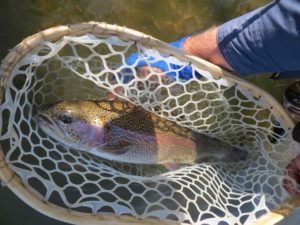
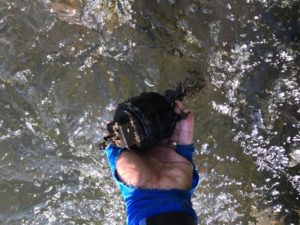
 Now organized by Clint Crookshanks, the Rodeo is held over the final weekend of July. Participants gather on Thursday night in Glenwood Springs to meet up and get their measuring troughs (to document the size of each of the up to 16 fish scored). On Friday, the teams spread out - fishing on public water only - to tackle the first four rivers: the Fryingpan, Roaring Fork, Crystal, and Colorado. On Saturday, action moves to the Gunnison basin with teams fishing the East, Gunnison, and Taylor Rivers as well as Spring Creek. If an angler misses one of the Friday rivers, they can make it up with the Slate as a fifth Saturday river.
Now organized by Clint Crookshanks, the Rodeo is held over the final weekend of July. Participants gather on Thursday night in Glenwood Springs to meet up and get their measuring troughs (to document the size of each of the up to 16 fish scored). On Friday, the teams spread out - fishing on public water only - to tackle the first four rivers: the Fryingpan, Roaring Fork, Crystal, and Colorado. On Saturday, action moves to the Gunnison basin with teams fishing the East, Gunnison, and Taylor Rivers as well as Spring Creek. If an angler misses one of the Friday rivers, they can make it up with the Slate as a fifth Saturday river. We stayed in Basalt and made it to the dam before sunrise. Only to find a line of folks already in place waiting to cast into the pool immediately below the dam. We went a bit downstream, crossed to the opposite side, and fished the far bank. Dustin landed his fish first - not a trophy, but a nice 15" brown trout. We relocated below the bridge where I landed a 12"er and was thus able to record my first Rodeo trout on the Fryingpan. One river down - and not even 9 am. We were flying high!
We stayed in Basalt and made it to the dam before sunrise. Only to find a line of folks already in place waiting to cast into the pool immediately below the dam. We went a bit downstream, crossed to the opposite side, and fished the far bank. Dustin landed his fish first - not a trophy, but a nice 15" brown trout. We relocated below the bridge where I landed a 12"er and was thus able to record my first Rodeo trout on the Fryingpan. One river down - and not even 9 am. We were flying high! Colorado while Dustin continued to hit the Roaring Fork - but close enough where we could both get to the other with the measuring trough if we landed something. We struck out there. Crossing the bridge and dropping to the opposite bank, Dustin caught our best fish of the weekend - an 18" whitefish. I continued to get nothing.
Colorado while Dustin continued to hit the Roaring Fork - but close enough where we could both get to the other with the measuring trough if we landed something. We struck out there. Crossing the bridge and dropping to the opposite bank, Dustin caught our best fish of the weekend - an 18" whitefish. I continued to get nothing. Saturday started with high hopes to get fish from five rivers and still complete our rodeo. But the luck that had been with me on the Colorado left me on the Gunnison. Fishing below the town of Gunnison in the morning, I hooked - and lost - a series of three fish. Dustin was also having no luck, so we decided a change of scenery was in order. We headed up to the Taylor River where we found a beautiful pool - complete with a break in the riverside trees to allow for a clear backcast - and both hooked into rising browns to score our Taylor River fish. Four rivers down - four to go.
Saturday started with high hopes to get fish from five rivers and still complete our rodeo. But the luck that had been with me on the Colorado left me on the Gunnison. Fishing below the town of Gunnison in the morning, I hooked - and lost - a series of three fish. Dustin was also having no luck, so we decided a change of scenery was in order. We headed up to the Taylor River where we found a beautiful pool - complete with a break in the riverside trees to allow for a clear backcast - and both hooked into rising browns to score our Taylor River fish. Four rivers down - four to go. headed over to the Roaring Judy Hatchery to fish the public reach of the East River there. Fishing around a tree with branches hanging over the river by where the hatchery springs flow out into the East, Dustin landed another brown trout. We swapped rigs, figuring that his set up would give me the best chance to land one as well. Of course, Dustin proceeded to hook another fish on my rod and fly ... another lesson in humility for me.
headed over to the Roaring Judy Hatchery to fish the public reach of the East River there. Fishing around a tree with branches hanging over the river by where the hatchery springs flow out into the East, Dustin landed another brown trout. We swapped rigs, figuring that his set up would give me the best chance to land one as well. Of course, Dustin proceeded to hook another fish on my rod and fly ... another lesson in humility for me. We finished the evening fishing the Gunnison at its source - the confluence of the East and Taylor Rivers - as a light rain continued to fall. While we hadn't succeeded - indeed, hadn't even come particularly close - it had been a great experience to fish together at so many different, beautiful spots in such a short time. We called it a day and headed over to the Almont Resort for dinner.
We finished the evening fishing the Gunnison at its source - the confluence of the East and Taylor Rivers - as a light rain continued to fall. While we hadn't succeeded - indeed, hadn't even come particularly close - it had been a great experience to fish together at so many different, beautiful spots in such a short time. We called it a day and headed over to the Almont Resort for dinner. Slate to replace the Crystal, which they like us had missed on Friday). Those well-earned smiles on their faces come with one year's worth of bragging rights - at least until the 2018 Rodeo. Overall, 12 of the 30 teams completed all 8 rivers. For the 10th anniversary year, there was also the option to complete 10 rivers (adding Brush Creek and Cement Creek on Friday and Saturday respectively). Three teams actually completed all 10 rivers - including the overall winners, the Triple Haulin' Nymphers (Dan Lundahl and Earl Hecker), who scored 257.3 inches on the 8 rivers (that's an average fish length of 16 inches!) plus another 51.8 inches on the two bonus rivers.
Slate to replace the Crystal, which they like us had missed on Friday). Those well-earned smiles on their faces come with one year's worth of bragging rights - at least until the 2018 Rodeo. Overall, 12 of the 30 teams completed all 8 rivers. For the 10th anniversary year, there was also the option to complete 10 rivers (adding Brush Creek and Cement Creek on Friday and Saturday respectively). Three teams actually completed all 10 rivers - including the overall winners, the Triple Haulin' Nymphers (Dan Lundahl and Earl Hecker), who scored 257.3 inches on the 8 rivers (that's an average fish length of 16 inches!) plus another 51.8 inches on the two bonus rivers.
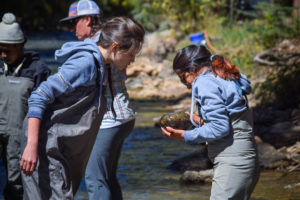
 CPW set up at the Zimmerman Lake inlet to capture spawning Greenbacks.
CPW set up at the Zimmerman Lake inlet to capture spawning Greenbacks. Fish were collected with a large net and put into a pen to be sorted and categorized by CPW staff and volunteers.
Fish were collected with a large net and put into a pen to be sorted and categorized by CPW staff and volunteers.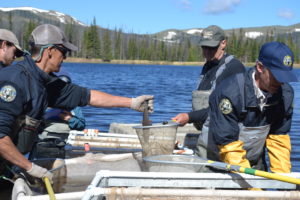 Fish were sorted based on their gender and stocking year.
Fish were sorted based on their gender and stocking year.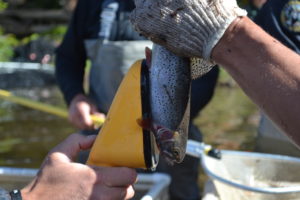 RFID chips in the fish help to identify the stocking year and other critical data.
RFID chips in the fish help to identify the stocking year and other critical data.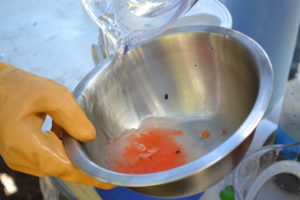 After the fish were sorted, CPW milked the males and females - making targeted genetic crosses among the various lineages to expand the genetic diversity. The eggs and sperm were combined in bowls, packed into small coolers, put on ice, and shipped to the local fish hatchery in Leadville, CO for breeding.
After the fish were sorted, CPW milked the males and females - making targeted genetic crosses among the various lineages to expand the genetic diversity. The eggs and sperm were combined in bowls, packed into small coolers, put on ice, and shipped to the local fish hatchery in Leadville, CO for breeding. Monday was the first full day of camp and after waking up, the kids went to the stream and pond at the ranch to learn about the entomology of the watershed. The kids took bug samples to learn about what the fish would be eating in the area and took water samples to determine the health of the stream and pond. After the sampling, students ate lunch and headed to nearby North Lake to fish for the afternoon. It wasn't long before kids started hooking into fish and in the first day over half of the kids had landed their first fish of the camp and for some, their first fish ever.
Monday was the first full day of camp and after waking up, the kids went to the stream and pond at the ranch to learn about the entomology of the watershed. The kids took bug samples to learn about what the fish would be eating in the area and took water samples to determine the health of the stream and pond. After the sampling, students ate lunch and headed to nearby North Lake to fish for the afternoon. It wasn't long before kids started hooking into fish and in the first day over half of the kids had landed their first fish of the camp and for some, their first fish ever. Over the first few days the kids had free time to tie flies and practice their fly fishing skills and on Wednesday they had a chance to hone in those skills and use the flies they have tied. The day started off by traveling to North Lake for the morning. While at North Lake kids were catching fish left and right and by halfway through the morning, everyone had caught a fish. After returning to the camp, the kids ate lunch and broke up into teams of three for some additional fishing. One group headed to some beaver ponds, another group fished the stream, and the third group fished a lake on the ranch property.
Over the first few days the kids had free time to tie flies and practice their fly fishing skills and on Wednesday they had a chance to hone in those skills and use the flies they have tied. The day started off by traveling to North Lake for the morning. While at North Lake kids were catching fish left and right and by halfway through the morning, everyone had caught a fish. After returning to the camp, the kids ate lunch and broke up into teams of three for some additional fishing. One group headed to some beaver ponds, another group fished the stream, and the third group fished a lake on the ranch property.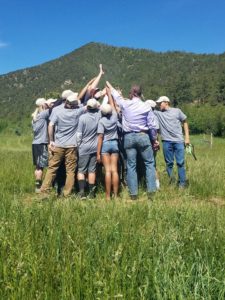 When the 15 campers arrived on June 11, there were nervous faces and uneasy feelings about what to expect for the upcoming week. But just a few days later on June 16 the campers had a hard time leaving one another. The friendships formed, the lessons learned, and the memories made will carry on forever and many students mentioned coming back in 2018.
When the 15 campers arrived on June 11, there were nervous faces and uneasy feelings about what to expect for the upcoming week. But just a few days later on June 16 the campers had a hard time leaving one another. The friendships formed, the lessons learned, and the memories made will carry on forever and many students mentioned coming back in 2018.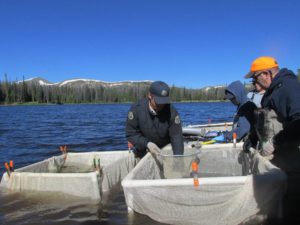 In the South Platte basin, Colorado TU and chapters worked to engage young, inner city, girls through the great outdoors by introducing them to fly fishing and conservation; CTU worked with Colorado Parks and Wildlife to reintroduce the Colorado state fish, Greenback Cutthroat Trout, to it's native watershed along the Front Range; Trout Unlimited tackled abandoned mine issues, and various chapters worked to repair their homewater streams from the devastating floods of 2013.
In the South Platte basin, Colorado TU and chapters worked to engage young, inner city, girls through the great outdoors by introducing them to fly fishing and conservation; CTU worked with Colorado Parks and Wildlife to reintroduce the Colorado state fish, Greenback Cutthroat Trout, to it's native watershed along the Front Range; Trout Unlimited tackled abandoned mine issues, and various chapters worked to repair their homewater streams from the devastating floods of 2013.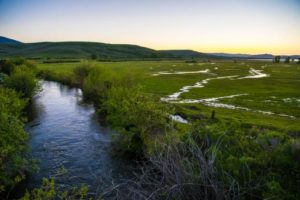 In the Colorado River basin, TU helped secure protections for the Roan Plateau and Thompson Divide from harmful oil and gas development, worked with local ranchers and farmers to improve the health of the Upper Colorado while enhancing agriculture water usage. TU also helped lead the Learning by Doing initiative that, among other things, secured $8 million in funds to protect and restore the Upper Colorado River.
In the Colorado River basin, TU helped secure protections for the Roan Plateau and Thompson Divide from harmful oil and gas development, worked with local ranchers and farmers to improve the health of the Upper Colorado while enhancing agriculture water usage. TU also helped lead the Learning by Doing initiative that, among other things, secured $8 million in funds to protect and restore the Upper Colorado River.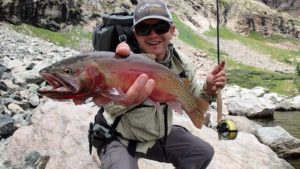 In the Rio Grande basin, Trout Unlimited worked to protect the Great Sand Dunes Cutthroat from potential changes in the environment. The Rocky Mountain Flyathlon came to Saguache for the annual race and fishing events that help raise money for Colorado TU's work in protecting native trout and their habitats. The local chapter and Trout Unlimited also worked to repair sections of the Conejos and ensure that winter flows were hospitable for trout.
In the Rio Grande basin, Trout Unlimited worked to protect the Great Sand Dunes Cutthroat from potential changes in the environment. The Rocky Mountain Flyathlon came to Saguache for the annual race and fishing events that help raise money for Colorado TU's work in protecting native trout and their habitats. The local chapter and Trout Unlimited also worked to repair sections of the Conejos and ensure that winter flows were hospitable for trout.
